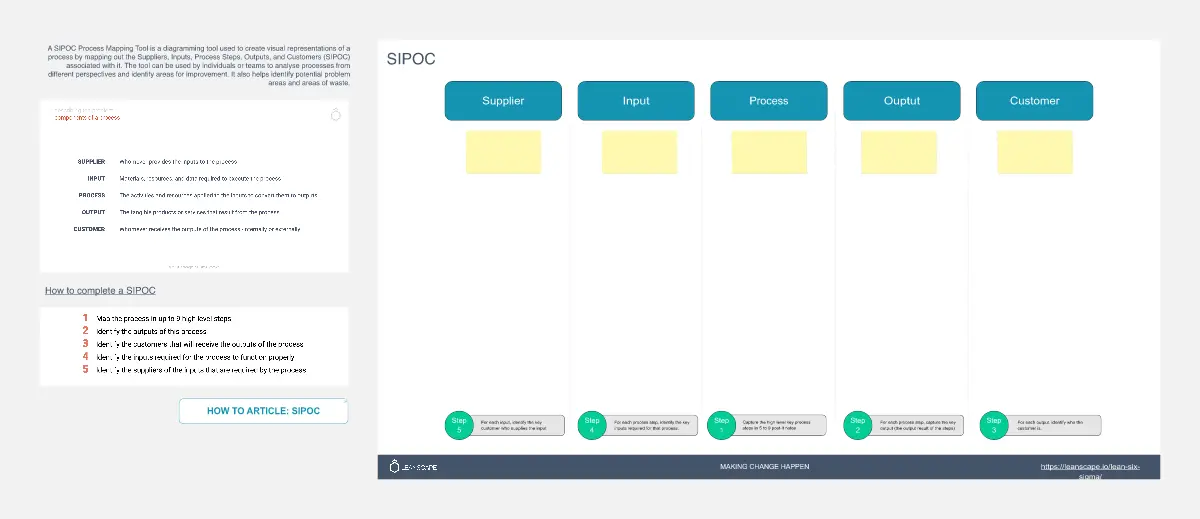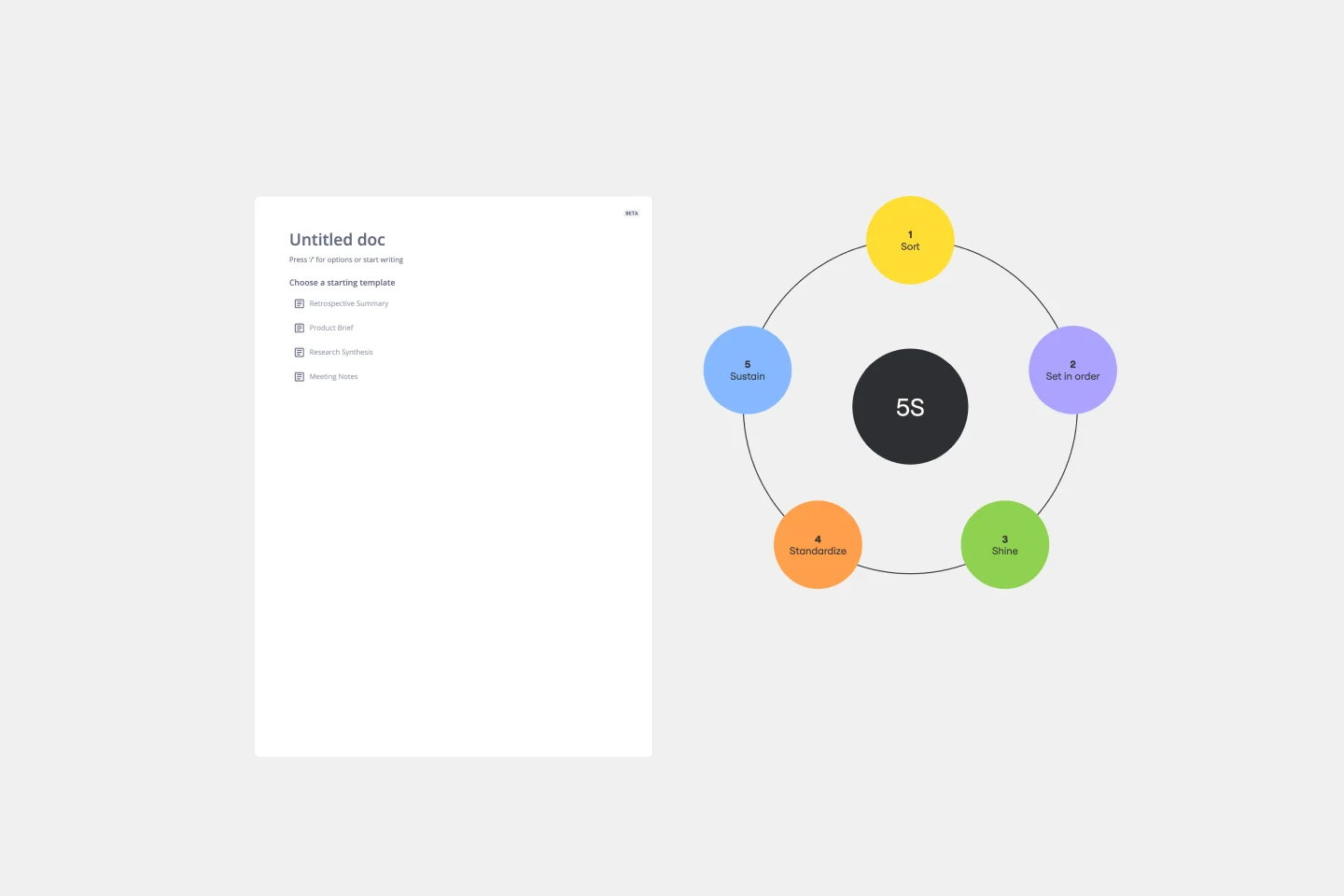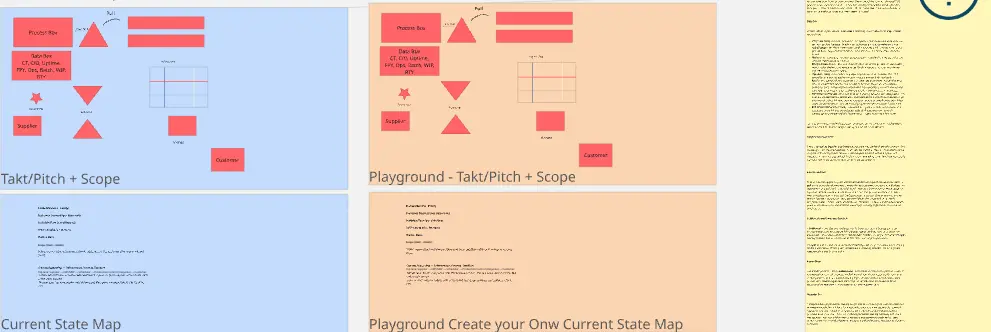Six Sigma templates
Optimize your processes with our customizable Six Sigma templates. Streamline your projects using proven tools for DMAIC, process mapping, and root cause analysis. Start improving efficiency and achieving measurable results with Six Sigma methodologies today.
17 templates
SIPOC Process Map
114 likes3.6K uses
SIPOC Process Map
The SIPOC Process Map is a visual tool for documenting the high-level process flow of a system or project. It helps teams identify Suppliers, Inputs, Processes, Outputs, and Customers, facilitating a holistic understanding of the value stream. This template enables teams to visualize key process elements and interdependencies, empowering them to identify areas for improvement and optimize workflow efficiency. By promoting transparency and collaboration, the SIPOC Process Map empowers organizations to deliver value more effectively and satisfy customer needs.
Value Stream Mapping Template
13 likes923 uses
Value Stream Mapping Template
A value stream map can help you refocus your business on steps that actually provide value to your customers, cutting out wasteful and inefficient processes. With this template, you and your process team can collaborate on a value stream map today.
Impact/Effort Matrix Template
10 likes900 uses
Impact/Effort Matrix Template
Growing organizations have countless to-do’s and only so many hours in a day (or weeks before a big launch) to get them done. That’s where an impact effort matrix comes in. It gives you a quick visual guide to help prioritize your tasks and know exactly what’s worth doing. Using our template, you can create a matrix that organizes your activities into four main categories: quick wins that are low effort, effort-intensive projects that provide long-term returns, fill-ins that are low effort but low value, and time-wasters.
Fishbone Diagram Template
7 likes432 uses
Fishbone Diagram Template
What is the best way to solve any problem your team faces? Go straight to the root. That means identifying the root causes of the problem, and fishbone diagrams are designed to help you do it best. Also known as the Ishikawa Diagram (named after Japanese quality control expert Kaoru Ishikawa), fishbone diagrams allow teams to visualize all possible causes of a problem, to explore and understand how they fit together holistically. Teams can also use fishbone diagrams as a starting point for thinking about what the root cause of a future problem might be.
Kanban Framework Template
7 likes369 uses
Kanban Framework Template
Optimized processes, improved flow, and increased value for your customers — that’s what the Kanban method can help you achieve. Based on a set of lean principles and practices (and created in the 1950s by a Toyota Automotive employee), Kanban helps your team reduce waste, address numerous other issues, and collaborate on fixing them together. You can use our simple Kanban template to both closely monitor the progress of all work and to display work to yourself and cross-functional partners, so that the behind-the-scenes nature of software is revealed.
SIPOC Template
0 likes185 uses
SIPOC Template
A SIPOC diagram maps a process at a high level by identifying the potential gaps between suppliers and input specifications and between customers and output specifications. SIPOC identifies feedback and feed-forward loops between customers, suppliers, and the processes and jump-starts the team to think in terms of cause and effect.
5 Whys Template
3 likes169 uses
5 Whys Template
Ready to get to the root of the problem? There’s no simpler way to do it than the 5 Whys technique. You’ll start with a simple question: Why did the problem happen? Then you’ll keep asking, up to four more times, until the answer becomes clear and you can work toward a solution. And Miro’s features enhance the approach: You can ask team members questions in chat or @mention them in comments, and use color-coded sticky notes to call out issues that are central to the problem at hand.
Kanban Framework AI Template
3 likes163 uses
AI Accelerated
Kanban Framework AI Template
Optimized processes, improved flow, and increased value for your customers — that’s what the Kanban method can help you achieve. Based on a set of lean principles and practices (and created in the 1950s by a Toyota Automotive employee), Kanban helps your team reduce waste, address numerous other issues, and collaborate on fixing them together. You can use our simple Kanban template to both closely monitor the progress of all work and to display work to yourself and cross-functional partners, so that the behind-the-scenes nature of software is revealed.
Project Charter Template
2 likes122 uses
Project Charter Template
Project managers rely on project charters as a source of truth for the details of a project. Project charters explain the core objectives, scope, team members and more involved in a project. For an organized project management, charters can be useful to align everyone around a shared understanding of the objectives, strategies and deliverables for a project of any scope. This template ensures that you document all aspects of a project so all stakeholders are informed and on the same page. Always know where your project is going, its purpose, and its scope.
5S Template
0 likes80 uses
5S Template
The 5S Template offers a systematic framework based on the renowned 5S methodology: Sort, Set in order, Shine, Standardize, and Sustain. Originally derived from Japanese manufacturing practices, this template provides clear directions to help teams optimize workspaces. A standout benefit of using this template is its capacity to drastically improve efficiency. Every resource and tool is positioned for maximum productivity by guiding users through decluttering and organizing, reducing time wastage, and enhancing overall workflow.
Root Cause Analysis (RCA) Template
0 likes79 uses
Root Cause Analysis (RCA) Template
The Root Cause Analysis (RCA) Template is a structured tool that helps teams uncover the underlying reasons behind specific problems or events. By pinpointing and addressing these root causes, rather than just treating the symptoms, organizations can foster long-term solutions and prevent recurring challenges, leading to more efficient and sustainable operations.
FMEA Analysis Template
0 likes77 uses
FMEA Analysis Template
When you’re building a business or running a team, risk comes with the territory. You can’t eliminate it. But you CAN identify it and mitigate it, to up your odds of success. Failure Modes and Effects Analysis (FMEA) is a powerful tool designed to help you manage risk and potential problems by spotting them within a process, product, or system. And you’ll spot them earlier in your process—to let you sidestep costly changes that arise late in the game or, worse, after they’ve impacted your customers and their experience.
DMAIC Analysis Template
1 likes60 uses
DMAIC Analysis Template
Processes might not seem like the funnest thing to dive into and examine, but wow can it pay off—a more efficient process can lead to serious cost savings and a better product. That’s what DMAIC analysis does. Developed as part of the Six Sigma initiative, DMAIC is a data-driven quality strategy for streamlining processes and resolving issues. The technique is broken into five fundamental steps that are followed in order: Define, Measure, Analyze, Improve, and Control.
PDCA Template
0 likes49 uses
PDCA Template
The PDCA template provides a visually compelling representation of the Plan-Do-Check-Act cycle, a foundational management methodology. Structured around four primary segments, this template helps teams systematically address challenges, test solutions, assess outcomes, and make necessary refinements. Using the PDCA template fosters continuous improvement. By cycling through each phase repeatedly, organizations can perpetually refine their strategies, ensuring they always move towards optimal solutions and processes.
Kaizen Report Template
0 likes46 uses
Kaizen Report Template
What makes a great company great? They know that greatness needs to be fostered and maintained — meaning they never stop working to improve. If you’re one of those companies (or aspire to be), a kaizen report is an ideal tool. It creates a simple visual guide to continuous improvement activities on a team, departmental, and organizational level. Using a kaizen report approach, every employee in an organization audits their own processes and understands what they might have overlooked, making this a powerful tool for increasing accountability at all levels.
Voice of the Customer Template
0 likes31 uses
Voice of the Customer Template
Identifying the voice of the customer is a crucial part of any customer experience strategy. Your Voice of Customer is simply a framework for understanding your customers’ needs, wants, preferences, and expectations as they interact with your brand. Evaluating your Voice of Customer allows you to dive into what your customers are thinking, feeling, and saying about your products and services, so you can build a better customer journey. Use the Voice of Customer template to record answers to key questions about your customer, including: What are they saying about our product? What do they need? How can we fulfill that need? And who is this persona?
Six Sigma Value Stream Mapping
0 likes12 uses

Explore more
About the Six Sigma templates collection
Miro's Six Sigma templates collection helps streamline your process improvement initiatives. Whether you're a seasoned Six Sigma practitioner or just starting, our templates provide a structured approach to problem-solving and process optimization. The collection includes a variety of templates such as DMAIC, SIPOC, and Six Sigma root cause analysis templates, all tailored to help you achieve operational excellence.
Why you'll love our Six Sigma templates
Using Miro's Six Sigma templates offers many benefits:
Standardization: Ensure consistency across projects with standardized templates that follow Six Sigma methodologies.
Efficiency: Save time with pre-built templates that allow you to focus on analysis and improvement rather than creating documents from scratch.
Collaboration: Enhance team collaboration with real-time editing and sharing capabilities, making it easier to gather input and feedback.
Visualization: Improve understanding and communication with visual tools that make complex data and processes easier to grasp.
Flexibility: Customize templates to fit your specific needs, ensuring they are relevant to your unique processes and challenges.
Accessibility: Access your templates from anywhere, at any time, ensuring that your team can work together seamlessly, regardless of location.
How to use the Six Sigma templates in Miro
Select a template: Choose one template from the Six Sigma templates category. You can select templates like DMAIC, SIPOC, or Six Sigma root cause analysis templates.
Customize the template: Tailor the template to your specific project needs. Add or remove sections, adjust the layout, and input your data.
Collaborate with your team: Share the template with your team members. Use Miro’s real-time collaboration features to gather input, make edits, and discuss findings.
Analyze and improve: Use the template to conduct thorough analyses. For example, use the DMAIC template to define, measure, analyze, improve, and control your processes.
Document and share results: Once your analysis is complete, document and share your findings with stakeholders. Use Miro’s export features to create reports or presentations.
Get inspired by our Six Sigma examples
Miro's Six Sigma templates are designed to help teams improve their processes through structured methodologies. Here are some examples of how specific templates can be used:
DMAIC: The DMAIC (Define, Measure, Analyze, Improve, Control) template helps teams systematically improve processes. By following the DMAIC steps, teams can identify problems, measure performance, analyze data, implement improvements, and control the new process to ensure lasting results.
FMEA Analysis: The Failure Modes and Effects Analysis (FMEA) template allows teams to identify potential failure points in a process and assess their impact. This proactive approach helps mitigate risks before they become significant issues, ensuring smoother operations.
SIPOC: The SIPOC (Suppliers, Inputs, Process, Outputs, Customers) template provides a high-level overview of a process. It helps teams understand the key elements involved in a process, from suppliers to customers. It ensures that all critical components are considered during process improvement initiatives.
By leveraging these templates, teams can enhance their process improvement efforts, leading to more efficient and effective operations. Miro's Six Sigma templates not only provide a structured approach but also foster collaboration and innovation, helping you achieve your business goals.
